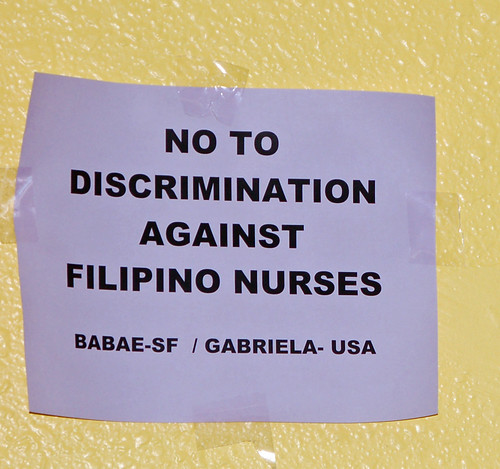Community advocates, doctors and nurses have charged ever since that, in a series of phases, Sutter-CPMC has been bleeding St. Luke's to death. If they succeed in killing it, the city will be left with only one hospital in its southern, browner, and poorer sections -- and that will be the under-funded, overwhelmed country hospital, San Francisco General. CPMC will operate 4 of the 10 hospitals in the richer, whiter northern section. Talk about economic segregation of health care … More details here.
Now Catherine Traywick at Spot.us offers a thorough account of one element of CPMC's kill-St.-Luke's-with-a-thousand-cuts strategy: they have apparently sought to end hiring of Filipino nurses.
The story is inflammatory. For decades hospitals have recruited immigrant Filipino nurses; these well-trained English speakers were thought to be willing to work harder and longer than natives while less likely to agitate for better wages and working conditions because of their non-citizen status.
Of course these nurses gradually became rooted in their new country, birthed citizen children and become natives themselves. However as more nurses of all ethnicities have seen the benefits of labor organizations, especially in Northern California some Filipino nurses have become militant labor activists and the hospitals find they confront an awakened work force. They don't like it.“Hospitals wanted to change the pay model so they hired professionals from the Third World to basically break unions,” said Peter Chua, professor of sociology at San Jose State University and author of Ating Kalagayan: The Social and Economic Profile of U.S. Filipinos. “Initially, there was an assumption that if you recruit them, they’ll be subservient,” Chua said. “Their contracts are set, so why would they join unions?”
And so, apparently at least some CPMC administrators have jumped from stereotypically thinking of their Filipino and Philippine-origin employees as subservient and passive to finding them aggressive and dangerous. At St. Luke's, Traywick reports employee accounts of management's directives:
Having been caught out encouraging racial discrimination in hiring, CPMC then compounded its descent into community infamy by trying to patronize the Filipino community. The CEO thought blogging about his delight in Filipino food might help. This led to outrage in the community.[U.S.-born Filipina nurse Jane] Sandoval first caught wind of a hiring ban in the spring of 2008. Two of her supervisors, Ronald Rivera and Ron Villanueva (both Filipino Americans), told her that they had overheard CPMC’s vice president of nursing Diana Karner say something to the effect of: We should probably not hire anymore foreign graduate nurses, because it is hard to understand them and be understood by them. The supervisors allege that Karner was referring specifically to Filipinos, who composed the vast majority of St. Luke’s foreign-trained nurses.
The nail in the coffin, as far as Sandoval was concerned, was a later statement made by Chris Hanks, St. Luke’s director of critical care from 2008 to 2009. Hanks, who reported directly to Karner at the time, attested that she had told him: “The Filipinos are always related, or know each other, and that’s not good. You’re not to hire them.”
… Shortly afterwards, the rate of Filipino new hires dropped dramatically, according to employee rolls reviewed by [the nurse's union.] According to CPMC, Hanks was “later fired for misuse of funds.”
CPMC, for its part, maintains that no ban ever existed and, while the company denies that Karner made the alleged statements, it concedes that, if she engaged in a conversation about foreign-trained nurses, it was in only light of “certain patient complaints (about) the nurse’s ability to effectively communicate,” according to a public statement released by the company. The statement further acknowledges “there has been a preference at St. Luke’s for bi-lingual (Spanish-speaking) nurses.”
“The hospital is in the Mission. The patient population is 60 percent Latino. Our nurses at St. Luke’s are 66 percent Asian,” said Kevin McCormack, CPMC’s media relations manager. “We need to make sure that we have nurses who can not only be linguistically sensitive to the patients but also culturally sensitive.”
This particular justification of an incident that, according to CPMC, never even took place, riled Sandoval. Along with many Filipino nurses at the hospital, she doesn’t speak Tagalog, doesn’t have a foreign accent and — like most brown-skinned Filipinos with typically Spanish surnames — is mistaken for Latino often enough. “I grew up in the Mission District, near St. Luke’s, so I know what this community is made of. If the managers would work side by side with us for 10 minutes, they would see there is no cultural divide,” Sandoval said. In essence: Filipino nurses and their Latino patients have more in common than a shared history of Spanish colonization.
The post sparked an intense ire in the Filipino American community. The San Francisco-based Filipino Community Center (FCC) released a statement calling Browner’s comments voyeuristic, an insult to injury and ultimately irrelevant.
“It’s like saying, ‘I can’t be racist, because some of my best friends are black,’ ” said Raquel Redondiez, vice chair of the Filipina advocacy group Gabriela USA. “It demonstrated how unsophisticated their understanding is of power dynamics, of race — even dynamics within a corporate organization.”
Browner subsequently removed the post, but the damage was done.

Signs on the walls of FCC.
Sutter-CPMC remains locked in struggle with the nurses' union (California Nurses Association) and the Mission community about the future of St. Luke's. Traywick's article is an important contribution to the story and worth a full read.
No comments:
Post a Comment